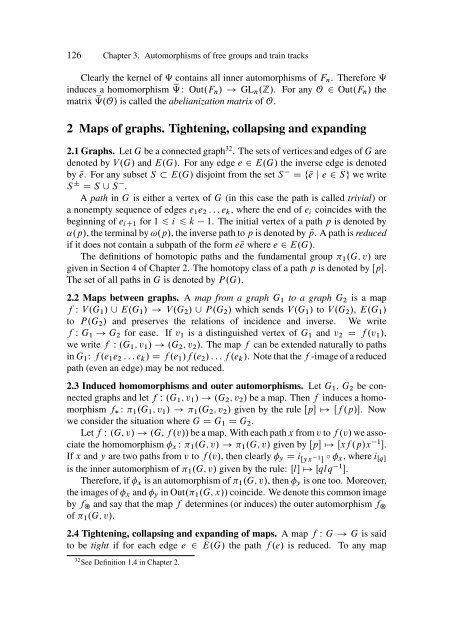Create successful ePaper yourself
Turn your PDF publications into a flip-book with our unique Google optimized e-Paper software.
126 Chapter 3. Au<strong>to</strong>morphisms of free <strong>group</strong>s and train tracks<br />
Clearly the kernel of ‰ contains all inner au<strong>to</strong>morphisms of F n . Therefore ‰<br />
induces a homomorphism x‰ W Out.F n / ! GL n .Z/. For any O 2 Out.F n / the<br />
matrix x‰.O/ is called the abelianization matrix of O.<br />
2 Maps of graphs. Tightening, collapsing and expanding<br />
2.1 Graphs. Let G be a connected graph 32 . The sets of vertices and edges of G are<br />
denoted by V.G/ and E.G/. For any edge e 2 E.G/ the inverse edge is denoted<br />
by Ne. For any subset S E.G/ disjoint from the set S DfNe j e 2 Sg we write<br />
S ˙ D S [ S .<br />
A path in G is either a vertex of G (in this case the path is called trivial) or<br />
a nonempty sequence of edges e 1 e 2 :::e k , where the end of e i coincides with the<br />
beginning of e iC1 for 1 6 i 6 k 1. The initial vertex of a path p is denoted by<br />
˛.p/, the terminal by !.p/, the inverse path <strong>to</strong> p is denoted by Np. A path is reduced<br />
if it does not contain a subpath of the form e Ne where e 2 E.G/.<br />
The definitions of homo<strong>to</strong>pic paths and the fundamental <strong>group</strong> 1 .G; v/ are<br />
given in Section 4 of Chapter 2. The homo<strong>to</strong>py class of a path p is denoted by Œp.<br />
The set of all paths in G is denoted by P.G/.<br />
2.2 Maps between graphs. A map from a graph G 1 <strong>to</strong> a graph G 2 is a map<br />
f W V.G 1 / [ E.G 1 / ! V.G 2 / [ P.G 2 / which sends V.G 1 / <strong>to</strong> V.G 2 /, E.G 1 /<br />
<strong>to</strong> P.G 2 / and preserves the relations of incidence and inverse. We write<br />
f W G 1 ! G 2 for ease. If v 1 is a distinguished vertex of G 1 and v 2 D f.v 1 /,<br />
we write f W .G 1 ;v 1 / ! .G 2 ;v 2 /. The map f can be extended naturally <strong>to</strong> paths<br />
in G 1 : f.e 1 e 2 :::e k / D f.e 1 /f .e 2 /:::f.e k /. Note that the f -image of a reduced<br />
path (even an edge) may be not reduced.<br />
2.3 Induced homomorphisms and outer au<strong>to</strong>morphisms. Let G 1 , G 2 be connected<br />
graphs and let f W .G 1 ;v 1 / ! .G 2 ;v 2 / be a map. Then f induces a homomorphism<br />
f W 1 .G 1 ;v 1 / ! 1 .G 2 ;v 2 / given by the rule Œp 7! Œf .p/. Now<br />
we consider the situation where G D G 1 D G 2 .<br />
Let f W .G; v/ ! .G; f .v// be a map. With each path x from v <strong>to</strong> f.v/we associate<br />
the homomorphism x W 1 .G; v/ ! 1 .G; v/ given by Œp 7! Œxf .p/x 1 .<br />
If x and y are two paths from v <strong>to</strong> f.v/, then clearly y D i Œyx 1 B x , where i Œq<br />
is the inner au<strong>to</strong>morphism of 1 .G; v/ given by the rule: Œl 7! Œqlq 1 .<br />
Therefore, if x is an au<strong>to</strong>morphism of 1 .G; v/, then y is one <strong>to</strong>o. Moreover,<br />
the images of x and y in Out. 1 .G; x// coincide. We denote this common image<br />
by f ~ and say that the map f determines (or induces) the outer au<strong>to</strong>morphism f ~<br />
of 1 .G; v/.<br />
2.4 Tightening, collapsing and expanding of maps. A map f W G ! G is said<br />
<strong>to</strong> be tight if for each edge e 2 E.G/ the path f.e/ is reduced. To any map<br />
32 See Definition 1.4 in Chapter 2.













